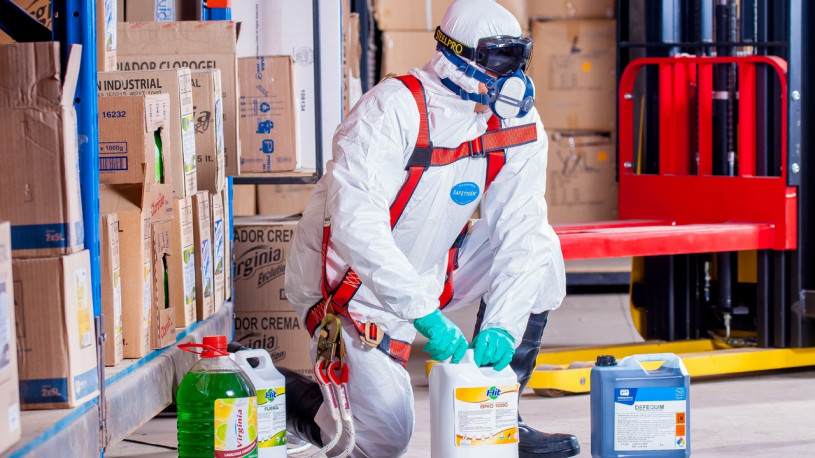-
How Household Chemicals could Easily Become a Nightmare.
 Continue Reading
Continue ReadingToday’s homes are becoming more and more like chemistry labs.
The huge number of household cleaning products that can be found there is a modern phenomenon. Such that few people can imagine their daily lives without the enormous range of cleaners in liquid, powder, gel or spray form that we use. These products are not just confined to the bathroom and kitchen, but are increasingly deployed, as if from crop dusting planes, on to windows, tiles, floors, lawns, cupboards, cabinets, hard furniture, soft furniture, curtains and carpets. They are added to toilets and baths, sinks and dishwashers. We fertilise our plants, use bug spray indoors and out, flea spray the cat and de-worm the dog. Even the family tortoise gets a dose of Mr. Muscle.
Then on ourselves we apply shampoos, soaps, shower gels, shaving foams, mouthwashes, toothpastes, perfumes, lotions, face creams, deodorants, suntan lotions, make up, make up remover, hair removal cream, hair growth tonic, antiperspirants and aftershaves.
We polish our shoes, the car, the table and our fingernails. We impregnate our coats, our footwear and our furniture. We de-odourise our feet and then aromatise our rooms.
After that, we use drugs.
Ointments and eye drops, insect repellants and bite creams, anti-histimines and mood modifiers. Drugs to keep us awake and others to make us sleepy. Capsules for this and suppositories for that. The list is near-endless.
Then we add chemicals to our food. We include baking soda, salt, preservatives, dyes, essences, colourings, starches, flavour enhancers and more.
The whole array of products, if left in the wrong hands, amounting to a small chemical weapons dump.
In fact, why was George W. Bush looking for chemicals in the Iraqi desert, if they were actually located under the kitchen sink?
Because these days, any amateur terrorist can learn online how to turn these harmless household products into highly effective smoke bombs, tear gases and combustion accelerators. Most of the ingredients are produced at a local, as well as a multinational level, and all are virtually untraceable.
Added to the fact that every second home is connected to the gas grid and it soon becomes quite difficult to have a restful night.
So maybe, in trying to prelong our lives and make ourselves prettier and healthier, we have inadvertently made a new threat. Alongside climate change and tectonic shifts, nuclear conflict and solar flares, we should now include the lethal environment which consumer society has created in our homes.
If this message scares you, then your fears are quite just. We have learnt to deal with many threats and dangers in the past, but maybe this new one requires more than a finger wag of caution. Maybe a new level of respect for chemicals should be established.
-
Silver – Rediscovering its Value
 Continue Reading
Continue ReadingSilver is one of the power three of precious metals. It may not have the glamour of gold or the purchase power of platinum, but it is a premier league metal. Possibly more so today than ever before, as it has been predicted that by the year 2018 its price will increase by a staggering 27%. This might make it of great interest for investors, but may have others wondering, “Why should we care about a metal that is inferior in so many ways?”
Well, primarily because it is a highly versatile element, that has multiple uses in the chemical industry. Firstly, it is used extensively as a catalyst in organic synthesis, for example in the manufacture of ethylene oxide. Which, from a layman’s perspective may not sound very interesting, but as a core component in antifreeze, it has real world applications. Furthermore, ethylene oxide is used to make polyester, a very versatile fabric.
Beyond that, silver is used in the field of water treatment, where its strong anti-bacterial effects are employed in an ever expanding range of cleaning facilities, which, by lessening dependency on other elements such as chlorine, reduces smell and simplifies complex filter systems.
For a long time, silver has also been used for its reflective purposes, for example in classic mirrors, where even today there is no full replacement. However, its reflective properties now have more modern applications, such as in solar panels, where silver is used as a polymer sheet, where it has a 95% reflection rate of sunlight.
At present the largest consumer of silver is the electronics industry, where its role in solder alloys has been irreplaceable in our progress to the modern world. Whilst it is also taking a growing part in the development of photo-voltaic cells and batteries.
Finally, it is important to mention silver’s use in jewellery, where its classic beauty will ensure its value long after the modern technological age has ended.
Whatever the historical reminiscences and current applications of silver are, it is certain that it has a bright prospect. This is a greatly sought after metal, one for our past, our present and our future.
Your team Spotchemi
-
How Sweden is Leading the Way in Biomass Processing
 Continue Reading
Continue ReadingPerhaps it is of little surprise that a country like Sweden, so rich in natural forests, is leading the way in technology to process residues and waste from its timber industry. But the fact that it has built a one of a kind wood chip processing plant is worthy of note.
What is different about this unit is that the technology is based on the processing of wood residue by gasification, where the process is carried out in two phases, and allows for much recycling in its own method.
In the first stage the feedstock (wood chip) is fed into a fluidized bed gasifier. Here it is heated to about 8,500C. At this point gasification occurs, induced by simultaneous injections of superheated steam (brought in from a separate combustion chamber). The resulting combustible gas is purified of tar, sulfur, and carbon dioxide.
In the second stage, the gas is drawn into methanization units, where the content of methane is condensed to more than 95% purity. The majority of this Bio-methane (bio-SNG) is sold to the gas grid or used in gas-fired power stations. A small percentage is set aside, and added to the feedstock for further processing.
Ash from gasification is used as fertilizer in the same forests where the biomass originated. Waste heat from both phases is used to make the superheated steam, as well as heat buildings close to the plant.
The process is interesting not only in the way that it utilizes a waste product (wood chips), but also in the amount of recycling of energy it performs inside its own process. At present, engineers are looking to utilize this process for different waste products, but to date this has not been achieved. This is due to the large amount of poisonous or hazardous substances that are created when wood chips are replaced with other waste products, and also because the process (due to its technological difficulty) can be prohibitively expensive.
However, as has been suggested in previous articles in this blog, waste is a huge challenge for the chemical industry of the 21st century. Developments like those being made in Sweden to recycle and reuse, show that we may be on the edge of a breakthrough.
